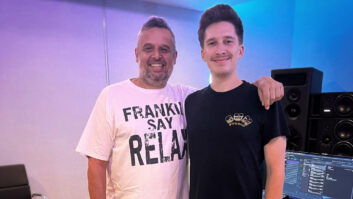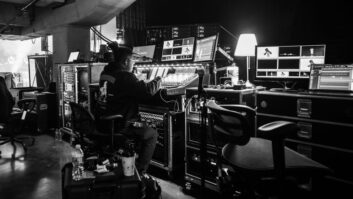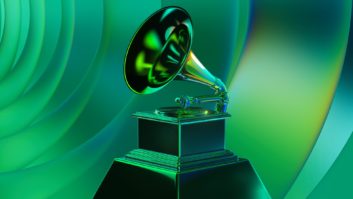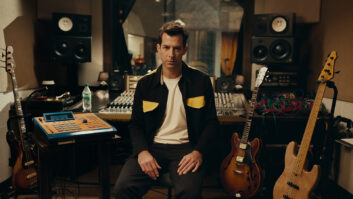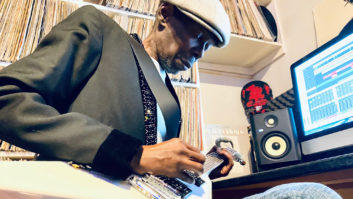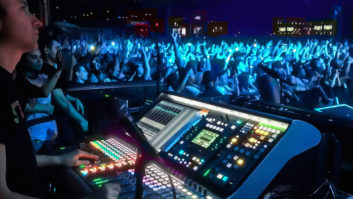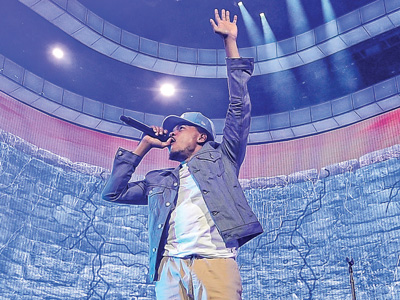
“I’m mixing on a Solid State Logic L500 Plus console,” says FOH engineer Kyle Bulman. “It has a great sound, workflow and there’s a bit of that classic SSL character in the preamp. But the converters and mix engine really stand in a league of their own. The front end is so good that it does remind me of a top-shelf analog desk. The character of each microphone and DI is on full display in a way that makes you rethink your normal choices. On the digital side, I never find myself wrestling with the channel EQ, compressors or internal headroom. The Stem architecture that is unique to the SSL lets you organize and route things without restriction.
“With this show, I ended up using both the onboard effects and plug-ins,” he continues. “The Dynamic EQ on the SSL is the best I’ve used. I have that on vocal mics and trumpet to help shape the more dynamic moments. I also use the onboard Variable Harmonic Distortion to give some grit and definition to the Moog Voyager, while the Sonic Enhancer and Chorus effects live on the Nord.
“For external plug-ins, there’s an SPL Transient Designer and Waves H-Comp on kick and snare for transient shaping and parallel compression. I use a Brainworks Saturator on the tom bus to help keep the toms from getting lost when everybody ramps up for a big moment. I also use a couple of Waves PSE instances to help manage bleed on the background vocal mics. There’s a Crane Song STC-8 compressor that’s just on lead vocal and a Rupert Neve Master Buss Processor that handles the compression for everything else. I use a Bricasti M7 for instrument reverb, a Lexicon 960 for vocal reverb, and the Lake LM44 is inserted on the vocal stems that feed FOH and front fills.”
Mix caught singer, songwriter, record producer and three-time Grammy Award winner Chance the Rapper in late April, at the beginning of his Be Encouraged tour, at the Golden 1 Center in Sacramento, Calif.
“I also mix on the SSL L500 Plus,” says monitor engineer Rob Ziemba. “I love being able to drag faders around and change my layout in real time, without audio interruption. I’m using the stems feature to feed all my talkback/shout mics into, which I matrix out with my cue, so I can always hear everyone, no matter what or who I have cued up.
“For plug-ins, I use the L500’s internal SSL bus compressor gently on each ear mix, which is great,” he adds. “I’m also using the internal Dan Dugan Automixer for all the talkbacks and shout mics. It’s been keeping things nice and clean.”
“Our vocal mic for Chance is the new Shure KSM8 capsule on Shure Axient sticks,” Ziemba says. “I haven’t had much on-the-job experience with the KSM8 capsule before this tour, but we’ve been really liking it. It sounded like someone took a blanket off the mic when we A/B’d it with some other popular capsules.”
“The tour does not have a lot of RF channels,” says RF tech Eric Marchand of Solotech. “We carry six channels of Shure Axient for Chance and the BGVs. The whole band and techs are using 14 channels of Shure PSM1000 for IEM. The complexity of the gig was mostly to find a way to bring the RF noise as low as possible for the receive antennas due to the LED wall creating destructive interferences. I was able to accomplish that by using the proper antennas for the RF mics and by keeping a great signal-to-noise ratio for the IEM using the proper cables.”
“Solotech is the sound company for the tour and it’s an all L’Acoustic system,” says system tech and audio crew chief Louis-Philippe Maziade, of Solotech. “Per side, the main P.A. is 14x K1 and 4x K2; flown sub is 12x KS28; side P.A. 18x K2; floor subs are 12x KS28; and fills are four Kara with two Arcs Focus. We use 4x X15Hiq for wedges and 4x Arcs as side fills. To maintain the same sound quality every show we use a Galileo 616AES and Galileo 616 to feed the rocket audio network, then going to the LA12X to be controlled by the LANetwork Manager. We have one computer with Smaart8 to view the frequency content of signals or measure the response of our electrical and electro-acoustic systems.”
While FOH mixer Bulmann determines mic choices and placement on drums, drum tech Kenny Stahl handles it day-to-day: Beta 91A and D6 for kick; Beta 57 and 181 on snare 1; MD-441 on snare 2; Beta 98Amp on snare 3; Beta 181 on hi-hat; Beta 98Amps on toms 1-4; a D6 on tom 5 and gong drum. Underheads are SE Electronic 4400a, three of which live in Kaotica Eyeball acoustic baffles with a figure-8 pattern.
“That allows me to minimize the bleed from the snare drums as they sit nicely in the null of each mic,” Bulmann explains. “The Eyeballs kill high-frequency reflections off the drum riser that would otherwise spill into the back side of the figure-8 pattern, and you end up with a very clean look at the cymbals, especially after some compression.”
